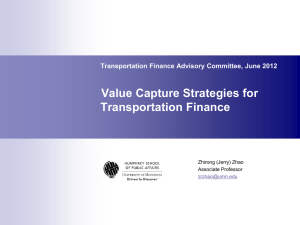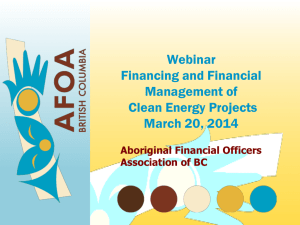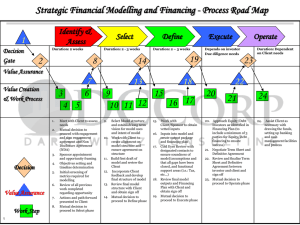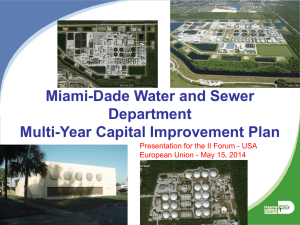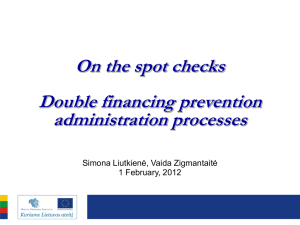Creative Financing for Energy Initiatives
advertisement
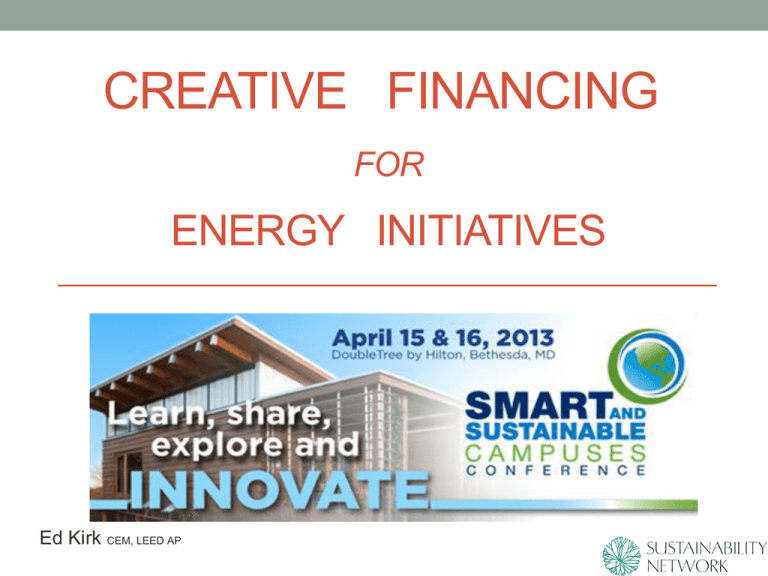
CREATIVE FINANCING FOR ENERGY INITIATIVES Ed Kirk CEM, LEED AP Are your projects getting funded? The mission of The Johns Hopkins University is to educate its students and cultivate their capacity for life-long learning, to foster independent and original research, and to bring the benefits of discovery to the world. • • • • • • University founded in 1876, Hospital in 1889 15,000 Students & 34,000 Faculty, Staff and Researchers Undergrad 2012 Tuition & Room and Board is $55K/yr 200+ buildings & 15M SF across 9 schools and campuses Endowment: $2.6B. Student aid: $250M annually Maryland's largest private employer and contributes more than $10B annually to the state's economy. • Energy Costs: > $50M annually JHU’s Decentralized Schools Medicine Public Health Music Real Estate Nursing International Studies President, Sustainability Business Arts & Sciences Education Engineering • Sustainability is smart and responsible actions that prioritize people, natural resources, and finances to safeguard the health of future generations. • Triple Bottom Line: Social, Environmental & Economical • Vision: A Sustainable Institution is where... • Natural resources are used responsibly • Buildings and grounds contribute to a sense of revival and rejuvenation • Zero waste – all waste is reused, recycled, repurposed, or composted • Sustainability is embedded in decision making, planning and actions • All members of the community are enriched by the experience Johns Hopkins University 2008 Campus GHG Report “51% Greenhouse Gas reduction by 2025” GHG Reduction Plan and Strategies Central Plants • Co-generation • System Optimizations • Energy Recovery • Conversion Efficiencies • Emissions Transportation • Centralize fleets • Vehicle Efficiency • Emissions Buildings (>95% GHG) • Energy audits & Metering • Re-Commissioning • Conservation upgrades • New Technology • Heat Recovery • Waste reduction • Building thermal envelope • Lighting and Controls Opportunities for onsite renewables • Solar PV • Solar Thermal • Bio-Fuels • Wind Behavior change • Education • Green Lab & Office • Green Reps. • Student engagement • Consultants • Designers Legislation Codes Incentives Goal Setting Peers Assessing Project Viability • • • • • • • • • First Cost Simple Pay-back Period Return on Investment Internal Rate of Return Net Present Value Life Cycle Cost Analysis Time Value of Money Principles Savings to Investment Ratio Adjusted Internal Rate of Return Other Financial Terminology •Analysis with Replacement: •Cost/Assessment: •Cash Flow: •Cash Flow Schedule •Current Salvage: •Discount Rate: •ECM Lifetime: •End of Life Salvage: •Fuel Price Inflation Rate: •Future Value (FV): •General Inflation Rate: •Improvement Analysis: •Internal Rate of Return (IRR):•Loan-to-value Ratio (LTV): •Maintenance Cost: •Net Cash Flow: •Net Present Value (NPV): •Present Value (PV): ◦Simple Payback ◦Savings to Investment Ratio (SIR) ◦Internal Rate of Return on Investment (IRR) •Saving to Investment Ratio (SIR): •Simple payback: •Upgrade Cost: Financing 101 • Return on Investment: Divide the total incentives and net savings of a project by the initial costs to implement, expressed as %. • Simple Payback Period: The number of years it would take to recover a project's costs. • Time Value of Money: The idea that money available at the present time is worth more than the same amount in the future due to its potential earning capacity. • Savings to Investment Ratio: The ratio of the present value of an energy saving stream with respect to the present value of the cost of making the energy efficiency improvements. • Net Present Value compares the value of a dollar today to the value of that same dollar in the future, taking inflation, the cost of money and returns into account. If the NPV of a prospective energy project is positive, it should be accepted. However, if NPV is negative, the project should probably be rejected because cash flows will also be negative. • Internal Rate of Return is the "annualized effective compounded return rate" or "rate of return" that makes the net present value of all cash flows from a particular investment equal to zero. If the IRR is greater than your internal cost of money (or assumed investment return), then you would have a financially attractive project. Life Cycle Cost is the total cost of ownership over the life of an asset. Life Cycle Cost Analysis is used to evaluate alternative designs that have higher initial costs but lower operating costs over the project life than the lowestinitial-cost design The formula relies on projections for Cost of $$, Inflation, Utility Rate Escalation, First Costs, Energy Savings, Maintenance and Repair Costs over the term… Traditional Project Financing Options • Self Fund: Cash, Use savings or Endowment, No interest financing, Operating funds. No Cash? No Problem… Performance Contracts Operating or Capital Leases On-Bill Financing Revolving Loan Funds Shared Savings Agreements Purchase of Power Agreements Performance Contracting This is a turnkey service, which provides customers with a comprehensive set of energy reduction measures and often is accompanied with guarantees that the savings produced by a project will be sufficient to finance the full cost of the project. A typical EPC project is delivered by an Energy Service Company (ESCO) and consists of the following elements: The ESCO provides all of the services required to design and implement a comprehensive project at the customer facility, from the initial energy audit through long-term Monitoring and Verification (M&V) of project savings. The ESCO arranges for long-term project financing that is provided by a third-party financing company, typically in the form of an operating lease. The ESCO provides a guarantee that the utility savings produced by the project will be sufficient to cover the cost of project financing for the life of the project. Definition: Energy Star Operating & Equipment Leases This type of financing does not appear as a liability on the company's balance sheet. A company may engage in off-balance-sheet financing if it wishes to keep its debt-equity ratio low and thereby appear as if it is carrying little debt. With an operating lease, a company rents, rather than buys, a capital asset. The company must record only the rental payments, and not the whole cost of the asset. While off-balance-sheet financing is permissible, it can become unsustainable and can hide a company's true financial state. Financial Dictionary. © 2012 Farlex, Inc Utility Company On Bill Financing On-bill financing refers to a financial product in a partnership with a utility company for energy reduction improvements in a building, and repaid by the building owner on their monthly utility bill. This allows a customer to pay back the cost of a project with the money saved on their monthly utility bill. This may be an attractive financing method to cash strapped customers. Revolving Loan Fund The Revolving Loan Fund is often referred to as a green revolving fund, when it is initiated on college and university campuses. These types of funds target projects that improve campus energy-efficiency, reduce resource use, or improve sustainability. These funds have become increasingly popular by universities, with loans issued to university departments or campus groups. The fund gets its name from the revolving aspect of loan repayment, where the central fund is replenished as individual projects pay back their loans, creating the opportunity to issue other loans to new projects. Shared Savings Agreement Under a "shared savings" contract, the Energy Service Company finances the project and takes the lion's share of the savings for a defined period. The end user has no up-front cost, guaranteed savings and improved equipment and operations. Purchase of Power Agreement A Power Purchase Agreement is a contract between two parties, one who generates energy for the purpose of sale (the seller) and one who is looking to purchase energy (the buyer). The PPA defines all of the commercial terms for the sale of energy between the two parties, including when the project will begin commercial operation, schedule for delivery of energy, penalties for under delivery, payment terms, and termination. So….Which Options Will Work for You? The Latest Trends at Hopkins Traditional Capital: Heat Recovery and Reuse, Central Plant & HVAC Optimization projects, Gray water re-use systems, Research support system enhancements, Metering and tracking Student Programs: CNG Shuttle fleet, Anaerobic Composter, Living Walls, Rain water run-off mitigation, Dash-boards On-Bill Financing/Utility Savings: Lighting retrofits, Controls Re-Commissioning, Window Films PPA: Solar PV and Solar Thermal Hybrid, CHP Questions? Ed Kirk, CEM, LEED AP Johns Hopkins University Energy Manager ekirk3@jhu.edu 443-997-2343




